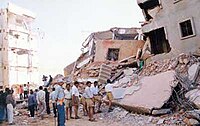
Photo from wikipedia
Abstract Two modes, reallocated reconstruction as well as in-situ reconstruction, are usually applied to post-earthquake reconstruction. This paper compares and analyzes the differences of the two modes empirically on the… Click to show full abstract
Abstract Two modes, reallocated reconstruction as well as in-situ reconstruction, are usually applied to post-earthquake reconstruction. This paper compares and analyzes the differences of the two modes empirically on the basis of the evaluations of the earthquake victims. Based on the framework outlined in the Tsunami Recovery Status Report issued by United Nations and the Overall Plan for Post-Wenchuan Earthquake Recovery and Reconstruction issued by China Academy of Urban Planning and Design, an evaluation indicator system is proposed, which consists of six categories of evaluation indicators, including livelihoods, urban housing, infrastructure, public services, eco-environment and spiritual homeland. The system is used to evaluate the degree of satisfaction with post-earthquake reconstruction from the perspective of measured residential satisfaction. This paper then presents the results of case analyses of two typical quake-hit regions in China's 2008 Sichuan earthquake, Wenchuan and Beichuan, which adopted reallocated reconstruction and in-situ reconstruction modes respectively for post-earthquake reconstruction. The analyses are conducted on the basis of survey data from 300 questionnaires and data from statistical yearbooks. The results show that (1) it is statistically significant that the reallocated reconstruction mode brings the higher total degree of satisfaction with post-earthquake reconstruction than the in-situ reconstruction does, and (2) the in-situ reconstruction mode only generates relatively better results than reallocated reconstruction does in terms of the spiritual homeland-related indicators, including neighbor relationship, communication with relative, family harmony, and health of families. The critical indicators affecting the total degree of satisfaction with post-earthquake reconstruction are identified as well, which are preservation and development of culture, governmental service and housing.
Journal Title: International journal of disaster risk reduction
Year Published: 2017
Link to full text (if available)
Share on Social Media: Sign Up to like & get
recommendations!